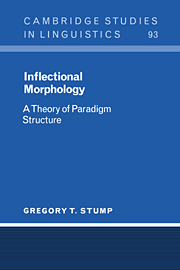6 - Stem alternations
Published online by Cambridge University Press: 14 October 2009
Summary
Introduction
A single lexeme may exhibit a variety of distinct stems within its inflectional paradigm. When it does, the question naturally arises why one stem is chosen over another in a particular cell of that paradigm. One might try to attribute the choice of one stem over another to a semantic difference between the two stems, or to an inherent difference in morphosyntactic feature content, or to some phonological exigency forcing the choice. But in a good many cases, such attempts are vain; that is, it frequently happens that the distributional difference between two stems follows neither from any systematic difference in meaning or morphosyntactic feature content, nor from ordinary phonological considerations. In view of the widespread incidence of such cases, one must simply assume that a lexeme's stems often carry indices whose sole function is to distinguish their mode of interaction with realization rules (and, more broadly, with rules of derivation and compounding). In the terminology of Aronoff (1994:25), the category of stems distinguished by an index of this sort is MORPHOMIC: it has no role in the grammar beyond the autonomous workings of the morphological component.
For concreteness, consider an example from Sanskrit. In Sanskrit, adjectives inflect for agreement with the case, number, and gender of the noun they modify; for instance, the masculine and neuter forms of the possessive adjective BHAGAVANT ‘fortunate’ are as in tables 6.1 and 6.2 (Whitney 1889: section 453).
- Type
- Chapter
- Information
- Inflectional MorphologyA Theory of Paradigm Structure, pp. 169 - 211Publisher: Cambridge University PressPrint publication year: 2001



